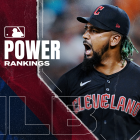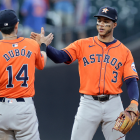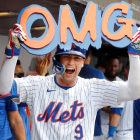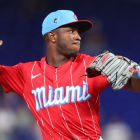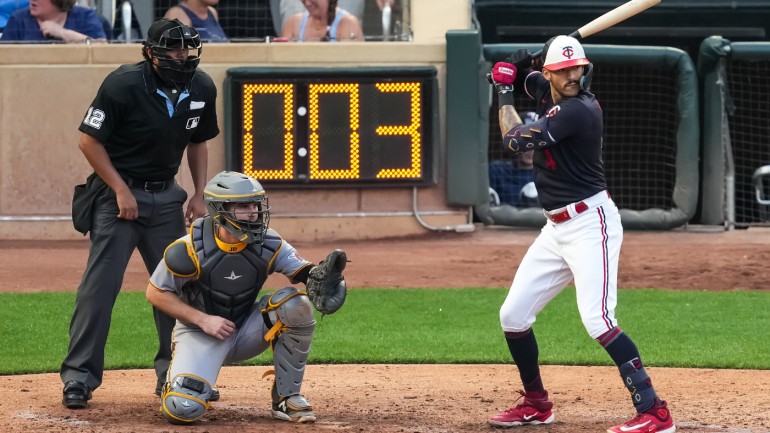
The baseball world learned Friday that the league has decided to leave the pitch clock as is for the playoffs. That is, the pitcher has 15 seconds to throw a pitch from the time the clock starts with bases empty, or 20 seconds with runners on. The batter has to be ready before there are eight seconds left on the clock.
Bravo, Major League Baseball.
MLB has a good thing going this season. The average attendance per game is the highest it has been since 2017. If we throw out 2020 and 2021 due to pandemic restrictions, the rise in year-over-year attendance -- 9.18% through August -- is on pace to be the highest it has been since 1998, and that year had two expansion teams. In terms of attendance per game, 23 of the 30 teams have seen increases in 2023 compared to 2022. TV ratings are similarly rising.
Is this all attributable to the pitch clock? I doubt that's the sole reason, but it would be folly to dismiss that it's had a significant effect. The pace of play getting slower and slower in recent years coincided with attendance and ratings dropping. Now there's a pitch clock and those same figures are going back up? There's something to it.
The playoffs in recent years have been incredibly exciting, but the one lingering complaint I kept hearing from fans who have "normal" jobs was that the games -- specifically the World Series games, which are the most important of the year -- ended far too late, far too often.
Now, right off the top, there's a balancing act with the time zones in the continental U.S. alone. The "just start the games earlier" crowd, then, is dismissing how much you screw over fans on the west coast if you moved the start times to around 7 p.m. ET. And the later we go after 8 p.m. ET, the more likely it was that the games would be ending after midnight on a work/school night on the east coast.
Basically, the league is pretty much forced to go with around 8 p.m. ET, at least on the weeknight games.
Enter the pitch clock.
The average time of game this season through the month of August was two hours and 41 minutes. One of the funnier complaints I've heard this season on the pitch clock is that players are "rushing." Does anyone who watched baseball regularly in August actually feel like the players look rushed? Maybe compared to the plodding from the past several years, but they don't appear to actually be hurrying. I'd go the opposite direction and say we only cut out the standing around nonsense that some might refer to as "dilly-dallying." The players, at least to me, most certainly do not look "rushed." They just look like baseball players playing baseball at a reasonable pace.
Also, the older generation of baseball fans should recognize the pace of play. The average game time from 1982-85 was between 2:40 and 2:44. Were the players rushing then? How about in the 1950s when the average time of game was around two and a half hours? Were they all "rushed" the entire time?
C'mon. We all know better. The players in the past two decades had simply gotten out of control in taking far too much time to both step in the box and throw the pitch. The pitch clock rule was implemented to dial it back and it's worked wonders.
Now, concerning that time of game in the playoffs, that'll rise to around three hours. We know this from data in past years (the average time of game in the playoffs last season was 15 minutes longer than the regular season). Perhaps the increase won't be quite as much, but the commercial breaks are longer. Yeah, I'm aware that some people would rather avoid doing that, but good luck messing with the almighty dollar. Plus, I'd rather have more action when we're watching actual baseball and more break time as opposed to less actual break time and a bunch of standing around on the field when it's supposed to be baseball time.
The goals moving toward the playoffs should be two-fold:
1. Give as many existing fans as possible the chance to reasonably see as much of the playoff games as possible.
2. Attract new fans.
The pitch clock will be a marked improvement over past years on both fronts. I've already covered No. 1.
As for No. 2, there are legions of casual sports fans who will turn into a playoff baseball game to check it out for a bit. The best way to bring them into the fold as long-term fans is to excite them. Faster-paced on-field action as opposed to standing around is a good way to do that. Having the most important games of the season end hours after bed time -- again, this argument absolutely has to include kids who are in school -- is a good way to drive them away.
Instead, we're about ready to see baseball show off its much faster-paced product to the casual sports fan world here in about a month. It's a huge opportunity.
The result this year should be the majority of the World Series games fitting nicely into a window from 8 p.m. ET to 11:15ish p.m. ET. That means ending times of 10:15 in the Central time zone, 9:15 in Mountain and 8:15 in the West. That's pretty damn reasonable and will work wonders in cashing in on this opportunity.
Again, bravo, Major League Baseball.










